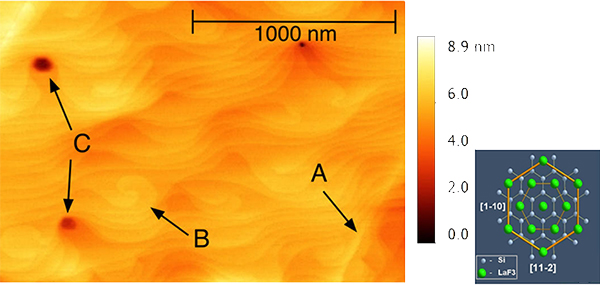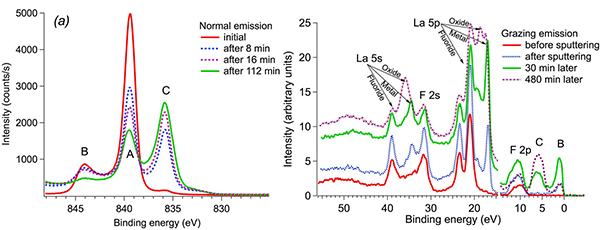Solid state ionics is a rapidly developing field, due to the number of possible applications (fuel cells, supercapacitors, sensing materials, batteries etc.). Highly crystalline Lanthanum Fluoride is a model example of F- ionic conductor.
LaF3 epitaxial films and heterostuctures have been studied on the GALAXIES beamline with Hard X-ray Photoelectron Spectroscopy (HAXPES) technique. LaF3 reactivity and composition of thin films were evaluated as a function of irradiation time and Ar ions sputtering, which is often applied in conventional photoemission to access deep layers. It was found that high purity LaF3 films form sharp interfaces with a silicon substrate, but they rapidly react at the surface, as a consequence of irradiation or sputtering, leading to F loss, La metal clustering and La oxidation.

Figure 1: AFM image of a 40nm LAF3 thin film on silicon. Different type of defects are marked by arrows (line defects, A; screw dislocations, B; voids, C). On the right, a top view of the LaF3 lattice orientation with respect to silicon.
Concerning ionic and superionic behavior, fluoride materials have often been considered as prototypical systems for the study of ion transport. This is due to the possibility to grow planar, highly ordered epitaxial layers and superlattices, with the formation of abrupt interfaces between adjacent materials with different conducting properties. This permits one to address the fundamental role of interface boundaries in ion transport. On the right, the atomic force microscopy image of a LaF3 film surface grown on Si(111) by molecular beam epitaxy shows monatomic steps of high crystalline quality. The fluoride crystal structure and a sketch of the experiment are also shown. An international team (Italy, Russia, France and South Africa) performed experiments on the GALAXIES beamline, to study the evolution of such layers under irradiation, sputtering or even heating. Their results were recently published in the Journal of Physical Chemistry.

Figure 2: HAXPES La3d5/2, F1s and O1s core levels respectively, measured at 2500 eV of photon energy on lanthanum trifluoride film. The different curves were taken at increasing irradiation times, 0, 15, 30 min for La3d5/2, F1s and 44, 88, 176min for O1s spectra. The spectrum acquired at T = 100 K for La3d5/2 is also shown (LT). The initial O1s spectrum has been fitted with three components. For visualization purposes, it has been multiplied by a factor of 10.
In fig. 2 changes of LaF3 after irradiation are shown. It can be easily distinguished that irradiation induces a progressive loss of fluorine from the surface. Even if the pristine film is pure, substitution of fluorine with oxygen takes place following irradiation. The effect can be explained in terms of the high mobility of oxygen through the created fluoride ion vacancies. The process seems to be mostly localized at the surface of the film. The formation of complex compounds with oxygen at the surface is confirmed by inspection of O 1s levels, as shown also in Figure 2. It is noteworthy that the overall oxygen amount increases almost linearly with time, suggesting that reactions take place between surface La after irradiation and the residual gas in the experimental vessel.
Effect of Ar+ Sputtering
Depth profiling of thin films by XPS is usually obtained through sputtering with noble gas atoms, typically Ar+.
La 3d5/2 core levels and valence band (VB) region of a 40 nm film were measured just after 15min of sputtering with Ar+ ions at 1 keV. Results as a function of increasing synchrotron photon beam irradiation in vacuum are shown in Fig 2. Even 8 min of irradiation are enough to create on the surface significant amount of metallic La clusters. VB region measurements clearly reveal features associated with metallic La at about 17 and 34.4 eV, which are assigned to La 5p3/2 and La 5s levels of the metal, respectively. Further irradiation causes a progressive film surface oxidation.

Figure 3(left). HAXPES spectra of La 3d5/2 levels of a LaF3 (40 nm) film after 15 min of Ar+ sputtering. Photon energy is 2500 eV. Figure 3(right). HAXPES valence band region and shallow core levels taken at grazing emission angle after 15 min of Ar+ ion sputtering of the LaF3(40 nm)/Si film at 2500 eV of photon energy. For visualization purposes, the energy axis has been split in two parts: in the high binding energy region, the spectra have been vertically shifted and rescaled, for better distinction of the structures, while in the low binding energy region they have been left as acquired to emphasize intensity variations between different curves.
Interestingly, 30 min after sputtering, the metallic related features are more pronounced compared with the just after-sputtering case, which seems to indicate that La migration and clustering at the surface is a dynamical process under the X-ray beam, by analogy to the non-sputtered surface.
These findings suggest that sputtering depth-profiling is not straightforward for these systems and related results should be considered accordingly, if one wants to address the bulk composition of a fluoride film. Erroneous conclusions can be easily derived. On the basis of the present results, it may be suggested that focused sample treatments (X-ray irradiation, sputtering, heating cycles) can be applied on purpose to tailor and modify the properties of the fluoride system, which may also have sizable influence on the ion transport properties of this material.
